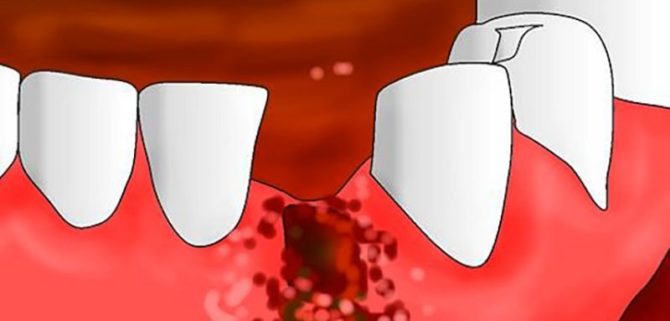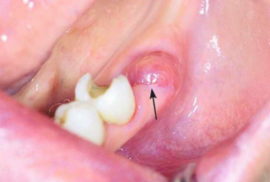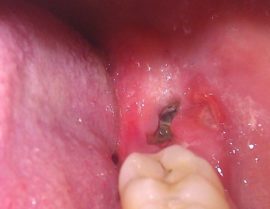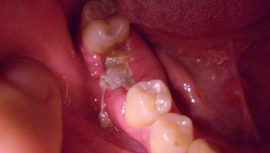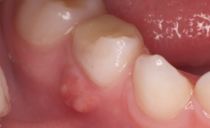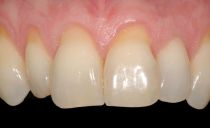Alveolitis after tooth extraction: symptoms, photos, treatment at the clinic and at home
Like other types of surgical intervention, tooth extraction may well lead to complications that need to be treated. Among all the possible consequences after tooth extraction, the most common alveolitis - inflammation of the hole, which cannot be treated at home because of the risk of developing more dangerous complications, for example, osteomyelitis.
Content
Causes of alveolitis after tooth extraction
Tearing out dental units per se is not a direct cause of alveolitis. The factors that provoke inflammation of the tooth socket are complications that arose during surgery:
- Injury to the wall of the alveoli, in which its root was fixed before tooth extraction.
- Penetration of infection into damaged tissue of the jaw.
- A dry hole after tooth extraction is the absence of a blood clot, which serves as a natural isolation of the resulting wound from pathogenic microorganisms.
- Tooth decay during tearing.
- The presence of curved roots of the extracted tooth or growths on their surface.
- Jamming of the root in the gum after removal of the crown.
- Using additional removal methods: sawing, cutting.
Molar teeth are large teeth with a large number of roots; therefore, alveolitis after removal of a wisdom tooth or adjacent molars appears more often than when tearing incisors.
Alveolitis can develop due to an infectious disease of the tooth to be extracted, or nearby gingival tissue:
- Chronic inflammation in the gums.
- The presence of caries, periodontitis.
- An abundance of plaque with actively multiplying microbes.
Inflammation can be triggered by improper actions by the dentist or patient: inadequate treatment of the instrument and wound, eating coarse food after surgery, and poor hygiene. Weak patient immunity increases the risk of inflammation.
Symptoms of alveolitis after tooth extraction
Alveolitis is an inflammation of the walls of the alveolar hole. Therefore, the disease is accompanied by all the local symptoms characteristic of the inflammatory process:
- Pain.
- Puffiness.
- Redness.
- An increase in local or general temperature.
There are other signs of the disease:
- The absence of a blood clot after surgery.
- Covering the wound with a gray coating.
- The spread of edema to the face.
- Swelling of the nearest lymph nodes.
- Offensive smell from the wound.
- Weakness.
As pus accumulates in the wound formed after tooth extraction, the symptoms of alveolitis intensify. A person begins to worry about weakness due to intoxication and fever, toothache radiating to the ear, temporal region.
Varieties of alveolitis, photo
Depending on the nature of the manifestation and development of inflammation in the tooth hole, several forms of alveolitis are distinguished:
| Form of the disease | Symptoms |
|---|---|
|
Serous |
Constant pain, worse when chewing. The temperature and the size of the lymph nodes do not change.Signs of serous alveolitis appear on the third day after tooth extraction and persist for about a week, after which the disease goes into a purulent stage. What does the serous alveolitis of the hole look like, look at the photo. |
|
Purulent |
Purulent inflammation develops a few days after tooth extraction in the absence of treatment for the serous stage of alveolitis and is manifested by more intense symptoms: severe pain, spreading of swelling on the face, and the appearance of a putrefactive odor. A wound in place of a wisdom tooth with this form of the disease looks like the one pictured. |
|
Hypertrophic |
Signs of violent inflammation subside (temperature decreases, lymph nodes decrease), but the chronic inflammatory process continues in the dentition, accompanied by the formation of granulations and the accumulation of dead tissue between them. Isolation of pus continues, the wound acquires a bluish tint and swells. What hypertrophic inflammation of the hole looks like after tooth extraction is shown in the photo. |
A separate type of inflammation at the site of the extracted tooth is toxic fibrosing alveolitis. It develops due to taking medications that lead to a decrease in immunity, or sulfa drugs. This form of the disease can develop in patients with autoimmune diseases.
Diagnostics
It is impossible to independently determine the diagnosis, we can only assume the development of inflammation in the hole. In order to diagnose the disease as soon as possible and begin its treatment, you should immediately consult a doctor.
The dentist finds out from the patient how much time has passed since the gum inflamed, how much it hurts. Examines the wound, checks for the presence of a blood clot, plaque, purulent odor in it. By external signs, a qualified specialist can establish an approximate diagnosis, but to determine the exact type of the disease, he may need additional examinations, for example, X-ray and CT.
Treatment of alveolitis after tooth extraction
Treatment of inflammation of the well after tooth extraction is carried out only after an accurate diagnosis and as directed by the dentist. Self-medication at home can lead to serious negative consequences, up to the loss of neighboring dental units and infection of the internal organs of the infection spreading through the bloodstream. At home, you can perform only those procedures that your doctor will prescribe.
Doctors can treat alveolitis, manifested after tooth extraction, using various methods. The tactics of therapy depend on how quickly the patient turned for help, at what stage the pathological process is, what are the individual characteristics of the patient's body.
If active necrotic phenomena with tissue death are not observed in the wound, the treatment will be limited to cleaning and disinfection of the hole. With advanced alveolitis, you need to remove all soft and hard tissues affected by the infection to stop the infection of healthy ones.
Treatment of early stages of alveolitis
If the patient asked for help immediately, as soon as his gums inflamed, then the treatment of alveolitis of the tooth socket will consist of the following stages:
- Local anesthesia.
- Washing the wells with an antiseptic solution.
- Purification of the hole from pus, destroyed elements of tissues and granulation particles.
- Repeated washing of the cavity of the well with an antiseptic.
- Drying the surface of the well with sterile gauze.
- Covering the wound with gauze moistened with an antiseptic.
How many times you have to visit the dentist to repeat all of these manipulations depends on the course of the inflammatory process. The longer the symptoms of alveolitis are felt, the longer it will take to visit a doctor and change applications with antiseptics.
The neglected forms of alveolitis
Launched alveolitis after tooth extraction requires intensive treatment using various drugs:
- As in the early stages of the disease, the cleansing and washing of the tooth hole with an antiseptic is performed. A tampon with medicinal preparations capable of relieving inflammation and normalizing microflora is placed in the hole. After this procedure, the wound hurts less.
- With a deep penetration of infection, lidocaine blockade should be done. How many injections are needed depends on the progression of the disease: if the condition does not improve the first time, the manipulation is repeated.
- If the hole contains dead tissue, the dentist removes them with proteolytic drugs. They lay such drugs with a gauze bandage.
- By the decision of the dentist, who assesses the degree of infection in the oral cavity, antibiotics can be prescribed in the form of drugs for local treatment or for oral administration. It is mandatory to rinse with antiseptic agents, which must be carried out at home.
With violent inflammation, the hole is very painful, in this case, you can take pain medication, but the doctor must choose an effective drug. Self-medication choices and prolonged use of analgesics can lead to serious complications.
Adjunctive therapy
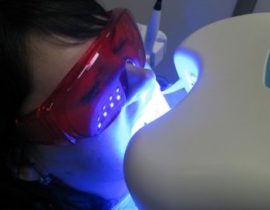 For the speedy healing of the inflamed hole, especially with the development of necrosis, additional treatment methods are indicated. The dentist may recommend:
For the speedy healing of the inflamed hole, especially with the development of necrosis, additional treatment methods are indicated. The dentist may recommend:
- Take a course of microwave therapy or fluctuation.
- Treat the well with an infrared laser or UV radiation.
- Resort to a balneotherapy procedure.
- When exposing bone tissue, make the smoothing procedure.
- Take vitamins.
Treatment of alveolitis after tooth extraction at home
Usually, the inflammation of the hole is treated using traditional methods and medications, but the disease at an early stage of development can be treated at home using folk remedies. The most effective method of stopping inflammation in the hole is the oral bath (holding fluid in the mouth) with a solution of potassium permanganate: 5 crystals per 1 liter of water.
In addition to a manganese solution, you can make baths with herbal decoctions. Broths of chamomile, St. John's wort, calendula, oak bark are suitable. It is recommended to take vitamin complexes that strengthen dental tissues and immunity.
If the inflammation of the hole has not subsided or intensified after several days of home therapy, it is urgent to consult a doctor. Self-medication should be completely abandoned with vivid symptoms of the inflammatory process, general malaise, and fever. Alveolitis can develop into osteomyelitis - inflammation of the bone tissue of the jaw, which can lead to its removal. Therefore, it is impossible to ignore this disease in any case.
Alveolitis after removal of a wisdom tooth
Most often, alveolitis develops during the extraction of third molars, which is associated with increased invasiveness of the operation: often cutting and exfoliating the gums, sawing the tooth into parts for easier extraction in the presence of curved roots.
Alveolitis in the field of dentistry is a rather rare disease. However, if when removing ordinary teeth, pathology occurs in only 2% of cases, then when removing extreme molars, the frequency of development of this disease increases to 20%. Symptoms and methods of treating inflammation of the hole from a wisdom tooth are standard.
Complications
If after treatment of alveolitis, the patient begins to hurt the hole, then it has become inflamed again. You will have to visit the dental clinic again, attempts to cure inflammation at home can aggravate it. For example, rinsing with hydrogen peroxide disinfects the wound, but this procedure eliminates the remnants of a blood clot, which makes the wound even more vulnerable to further penetration of pathogens. That is why rinses are replaced with oral baths.
Complications in the form of infection spreading deeper into the maxillofacial apparatus include osteomyelitis, phlegmonous tissue fusion, and an abscess. If pathogens and their toxins en masse enter the bloodstream, a person is at risk of sepsis, which in the absence of surgical treatment can lead to death.
Do not underestimate a disease such as alveolitis, since it can cause great harm to the body. Only a timely visit to the dentist to eliminate the infection will help prevent further tissue destruction. Therefore, after removing the incisor, canine or molar, you need to monitor the condition of the gums so as not to miss the first signs of inflammation.

